You are using an out of date browser. It may not display this or other websites correctly.
You should upgrade or use an alternative browser.
You should upgrade or use an alternative browser.
Converting a hubmotor to a middrivemotor
- Thread starter crossbreak
- Start date
crossbreak
1 MW
the down tube screw is worth a lot i can imagine. i was afraid of drilling holes into it, that's why I didn't try yet. clamps can be very stiff, too.
AFT uses a very heavy duty clamp around the down tube.
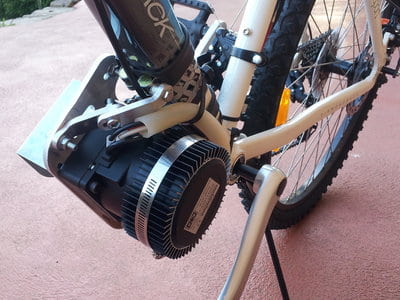
This" one-bolt" style can be found at McMaster-Carr in stainless steel for roughly $8 around a 2-inch diameter, also ebay
http://www.mcmaster.com/#standard-hose-clamps/=m6xc8y


I like the dual bolt version...run all-threaded-rod through the lower part, tighten the bolt on the top to snug it up around the down tube, and then the lower part provides two threaded mounts?
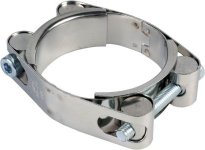
This" one-bolt" style can be found at McMaster-Carr in stainless steel for roughly $8 around a 2-inch diameter, also ebay
http://www.mcmaster.com/#standard-hose-clamps/=m6xc8y


I like the dual bolt version...run all-threaded-rod through the lower part, tighten the bolt on the top to snug it up around the down tube, and then the lower part provides two threaded mounts?

crossbreak
1 MW
great clamps! but i guess normal pipe clamps (the ones with just two srews) will do the job. my next mount will use them. my design will look a bit like lightningrods GNG mount. he had some great design ideas i like to use also.
next version will mount a bafang BPM, time to make nails with hats
next version will mount a bafang BPM, time to make nails with hats
tri-lobe
100 W
hello crossbrake...
you've got me in...i have just recieved 2 bafangs...to follow what your doing though i will mount in a swing-arm....40mm differance in dia to gng motor.....not a large lengthening from 1.025mm wheelbase to 1.065mm wheelbase...and all the benifits of your method.....
so i give you fair warning....i shall copy you to suit my needs.....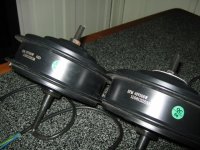
thank-you for posting your ideas.....i'm continually gobsmacked by the problem solving ability of ES members.
you've got me in...i have just recieved 2 bafangs...to follow what your doing though i will mount in a swing-arm....40mm differance in dia to gng motor.....not a large lengthening from 1.025mm wheelbase to 1.065mm wheelbase...and all the benifits of your method.....
so i give you fair warning....i shall copy you to suit my needs.....

thank-you for posting your ideas.....i'm continually gobsmacked by the problem solving ability of ES members.
crossbreak
1 MW
hi tri lobe!
nice to hear that! i will buy a front motor, since it has a shorter axle. that makes mounting sprockets easier. but dont mind, it will work with yours almost as well. which wind did you buy? i wanna buy a code 09 or code 10.
nice to hear that! i will buy a front motor, since it has a shorter axle. that makes mounting sprockets easier. but dont mind, it will work with yours almost as well. which wind did you buy? i wanna buy a code 09 or code 10.
crossbreak
1 MW
i'd say it's code 12 from the pic. do you wanna use 72V or why did buy such a slow wind?
MitchJi
10 MW
Hi,
I figured out how to get substantially more (something like 1.75x-2x!) motor reduction (higher motor RPM) with the pedals driving the motor shaft and the motor driving the rear sprocket configuration.
I figured out how to get substantially more (something like 1.75x-2x!) motor reduction (higher motor RPM) with the pedals driving the motor shaft and the motor driving the rear sprocket configuration.
Neither Eric (greenmachine) running 2,500 watts with his aluminum heat-bridge side cover, nor Whiplash had a problem with excessive heat. So I think the weak links with the MAC are gears and bearings. Steel gears are available if necessary. Noisier but oil-cooling will quiet it down to some extent and further reduce any heat issue. How hard is it to replace/upgrade the bearings?Whiplash said:LOL! With my first gear top speed on my MAC mid drive, of 12 MPH (TESTED) at only 1200 watts I could pull out a small stump, with that combo you could pull a small house down! LOL!
I have actually come to the realization the MAC is limited in its peak torque that the gears can handle, so you have to be careful how much you overdrive the gear ratio because it'll try to do it and kill the gears or bearings in the process.
How much power do you plan to run through it? How much power can a crossbreak modded Bafang reliably handle? More than 2.5kw? Gears and bearings not a problem?spinningmagnets said:Whiplash, I am still learning, but...it's looking like eddy current losses will make the 6T / 8T MACs less than ideal at over 1,000-RPMs, and due to the lower pole-count of the Bafang, it can run twice as many RPMs without eddy-current waste-heat (2,000-RPM?)....
Looks good, Whiplash! After much research I am finally persuaded that the Bafang is the best motor for conversion by far. I will finish up the MAC conversion with pics, and buy the fast turn-count Bafang (8T?) for 2,064-RPMs @ 48V...
tri-lobe
100 W
hey crossbreak..crossbreak said:i'd say it's code 12 from the pic. do you wanna use 72V or why did buy such a slow wind?
i purchased the 12 as a replacement for my hubmotor set-up with a spare motor for parts....with the impression from the supplier that these were a fast rpm ie 210rpm in a26"wheel @ 48V.....
I got the impression from reading the posts about the MAC motor and the bafang motor......that if winds inside the motors was different....one could still build the external gearing to get a workable rear end...
these 12's is what i have on hand....so it shall be that one of these motors that will be turned inside-out.....
crossbreak....am i flogging a dead horse with this motor for this application ??????
MitchJi
10 MW
Hi,
The advantage of 6:1 vs 5:1 or needing less reduction for the same motor RPM are that you can run the motor at a higher RPM for a given speed. I don't understand why you think the chain speed makes any difference in this context.crossbreak said:It's true what you say, if we look at the rpm of the shafts (the pedal shaft turns slower than the Jackshaft)
But: If we look at the chain speed, we see it does not change much in a regular "freewheel-crank-drive" either, since both (input and output) chainwheels are about equal size. The chain speed of the motor->crank chain is almost the same as the speed of the crank->wheel chain.
I don't see how that's an advantage.crossbreak said:The advantage "double FW Jackshaft drive", that there is one less chain drive between motor and wheel is so obvious, I just forgot to mentionI'll add that, thx for the advise!
crossbreak
1 MW
MitchJi said:Hi,
The advantage of 6:1 vs 5:1 or needing less reduction for the same motor RPM are that you can run the motor at a higher RPM for a given speed. I don't understand why you think the chain speed makes any difference in this context.crossbreak said:It's true what you say, if we look at the rpm of the shafts (the pedal shaft turns slower than the Jackshaft)
But: If we look at the chain speed, we see it does not change much in a regular "freewheel-crank-drive" either, since both (input and output) chainwheels are about equal size. The chain speed of the motor->crank chain is almost the same as the speed of the crank->wheel chain.
I don't see how that's an advantage.crossbreak said:The advantage "double FW Jackshaft drive", that there is one less chain drive between motor and wheel is so obvious, I just forgot to mentionI'll add that, thx for the advise!
Why is that no advantage? Are better efficiency and less wear a bad thing?
The 6:1 reduction is no advantage of the dual feewheel jackshaft drive. It's an advantage of converting hubs in general, does not depend on which drive you choose.
We already talked about metal gears here. IMO that makes no sense, because the torque region at which the gears begin to fail are not worth to reach, due bad efficiency. If you want double the output, just use 2 of the motors
tri-lobe: if you choose the right voltage this motor is just fine. I just dont like systems with more than 60V, but i'm an outsider here since I care for laws, specifications and standards. The electrical system get's a lot more complicated if one uses 60V+ within VDE specs. I'd like to see people from the sphere care more about this either. IMO It's very important that the germans use their knowlage in standardisation here, to establish safe vehicles made with our know-how, using well developed standards like CAN-bus with build-in safety features. We have a road map here among other things: http://www.vde.com/en/dke/std/Pages/EMobility.aspx
My bafang conversion has to wait a bit. First I want to build a Crystalite HS3540 into my commuter. Merlin showed me this motor can take 4kW short term and I like it a lot
crossbreak
1 MW
thx for your awesome MAC conversion tutorial , spinningmagnets! http://endless-sphere.com/forums/viewtopic.php?f=28&t=45245&start=450#p719603
I have highlighted a link to your tutorial in the the second post and I added some warnings:
I have highlighted a link to your tutorial in the the second post and I added some warnings:
Warning1! The peak output power is NOT influenced by this conversion. If you could drive your Hub@1kW for a minute, that does not mean you can drive it with 3kW after conversion! But you can drive it with 1kW continuously without overheating it.
Warning2! You might think now that you could still double your output power by changing the plastic gears for metal ones, this is true, but high torque leads to low efficiency due saturation of the magnetic path in the motor! This is why I do not recommend using metal gears. I simply replace my plastic gears once in a year, they are cheap and run much more quiet.
Warning3! Up-Speeding your motor does raise output power, but it has limits. As a rule of thumb, 250Hz field-change-frequency should not be exceeded for motors with 0.5mm laminations, since eddy current loss raises a lot at higher rpm. This means your should not run your rotor faster than:
*1000rpm for the MAC
*2000rpm for the Bafang BPM
*1750rpm for the Bafang SWXB and SWXH
tri-lobe
100 W
hello crossbreak...
thankyou for your reply.....particularly the standards aspect......i agree....i'm quite happy to stay below 60v.....48v to 56v is where im at now....
so i'll order the motor with the wind that you have suggested.....i would like to get the motor and battery voltage marriage correct to start with.
thank-you for the heads-up......
thankyou for your reply.....particularly the standards aspect......i agree....i'm quite happy to stay below 60v.....48v to 56v is where im at now....
so i'll order the motor with the wind that you have suggested.....i would like to get the motor and battery voltage marriage correct to start with.
thank-you for the heads-up......
This is Part-2, continued from the pic-tutorial here:
http://endless-sphere.com/forums/viewtopic.php?f=28&t=45245&start=450#p719603
View attachment 6
View attachment 5
View attachment 4
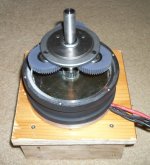
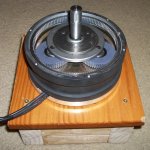

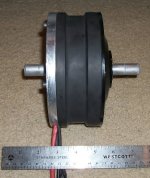
http://endless-sphere.com/forums/viewtopic.php?f=28&t=45245&start=450#p719603
View attachment 6
View attachment 5
View attachment 4




I will post more pics this weekend, I have determined that I will need to add an extra circlip groove to the shaft and a short sleeve adapter (17mm ID / 24mm OD, 10mm long). This will require me to bore out the the 20mm center hole of the planet-gear sideplate to 26mm. Boring this hole requires that I remove the side-plate bearing first.
This is the 17mm-bore sleeve-adapter I used:
Go Kart Aluminum Wheel Spacer 17mm I.D X 1/2" long
Ebay Item# 221157071057
Aluminum expands more than steel when heated, so I set the sideplate on an electric stove set on low (I used low, so I wouldn't damage the plastic side dust-seals of the bearing). When the side-plate was warm, I set it on a large socket to support the aluminum plate around the bearing (with the plate facing black side up). I used the stock shaft as a punch and the bearing came out easily.
If the bearing does not come out easily and you have to really pound it, they can be damaged by this process, so you may need to buy a replacement bearing, I would try VXB.com (unless you have another preference), because I have had good luck with them in the past.
Both side-plate bearings are 17mm ID, 30mm OD, 7mm thick...the part number on the stock MAC bearing plastic side-seal is: 6903RS
http://www.vxb.com/SRCH.html?Store_Code=bearings&Search=6903rs
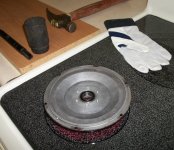
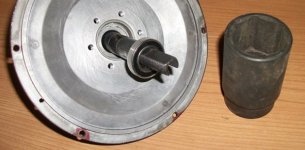

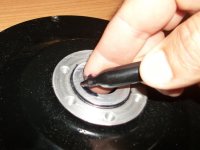
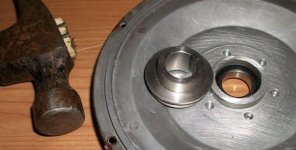
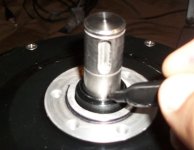
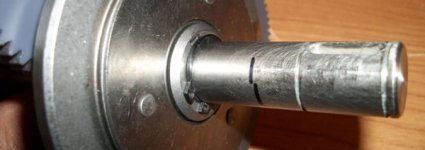

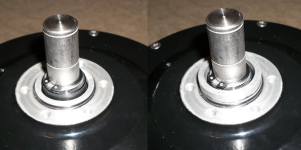
This is the 17mm-bore sleeve-adapter I used:
Go Kart Aluminum Wheel Spacer 17mm I.D X 1/2" long
Ebay Item# 221157071057
Aluminum expands more than steel when heated, so I set the sideplate on an electric stove set on low (I used low, so I wouldn't damage the plastic side dust-seals of the bearing). When the side-plate was warm, I set it on a large socket to support the aluminum plate around the bearing (with the plate facing black side up). I used the stock shaft as a punch and the bearing came out easily.
If the bearing does not come out easily and you have to really pound it, they can be damaged by this process, so you may need to buy a replacement bearing, I would try VXB.com (unless you have another preference), because I have had good luck with them in the past.
Both side-plate bearings are 17mm ID, 30mm OD, 7mm thick...the part number on the stock MAC bearing plastic side-seal is: 6903RS
http://www.vxb.com/SRCH.html?Store_Code=bearings&Search=6903rs









Test run the motor to see if there are any glaring issues or bad noises. I actually first spun this motor using 24V of SLA through an RC sensorless ESC as a controller.
If it all sounds good, dis-assemble, clean everything, fully grease the gears, and reassemble with a drop of locktite fluid on the threads of any bolts that you don't want to vibrate loose. More info a few months from now after I finish the mounting bracket and get a few miles on it in the real world.
If it all sounds good, dis-assemble, clean everything, fully grease the gears, and reassemble with a drop of locktite fluid on the threads of any bolts that you don't want to vibrate loose. More info a few months from now after I finish the mounting bracket and get a few miles on it in the real world.
is Green selling these conversion bits??
I don't know, I was under the impression that he was going to buy a batch of MACs, and convert them to sell with the batch of fat-tire sand/snow bikes he has ordered. Because of my unique position as spell checker emeritus and occasional writer for electricbike.com, I was able to beg a shaft and sideplate. The extra aluminum mass of the sideplate was a welcome addition, though probably not "necessary", but...the solid shaft with key-slots for the spockets was a highly desired item from my perspective.
I suspect the Bafang BPM will prove to be as useful as the MAC for conversion to a shaft-drive (issues for that have yet to be determined, the BPM may not work...I guess we'll see in time), but that conversion will have to wait until next month as I am swamped at the moment.
bandaro
10 kW
So loving the idea guys, but I still have some doubts, primarily regarding to weight/power ratio.
How much does one of the geared hubs you guys are using weigh? and constant power you're getting? I would prefer to have the mass as "thermal mass" as someone put it, rather than in reductions, as the motor could take a little more abuse than an outrunner, but I am after lightweight as a main goal, silent would be nice but not essential...
Just trying to check out other option again before I buy parts for a new build in august...
How much does one of the geared hubs you guys are using weigh? and constant power you're getting? I would prefer to have the mass as "thermal mass" as someone put it, rather than in reductions, as the motor could take a little more abuse than an outrunner, but I am after lightweight as a main goal, silent would be nice but not essential...
Just trying to check out other option again before I buy parts for a new build in august...
Bandaro, the MAC is an outrunner inside the shell. The appeal of that for me is that compared to another motor that is an inrunner and has a comparable size, the outrunners magnetic flux (the magnet air-gap, where the work is applied to the rotating bits) is farther away from the shaft center, giving an outrunner more leverage, and thus more torque per the same watts applied to the stator-coils.
As far as weight, I like that the MAC has more copper mass than the GNG-V1
If you like that idea, but want extra quiet, consider getting a slow 12T, converting it to shaft-drive, and removing the planets. Make an aluminum adapter to pin the shaft to the sun-gear on the magnet-ring/bowl, and add a belt-reduction to the 17mm shaft. You can also use a hole-saw to remove 40% of the mass of the magnet-bowl, so it looks like the Bafang magnet-bowl.
edit: the un-geared 12T MAC has a Kv of approximately 30...30-RPMs per volt,...6T is 60-Kv, and so the 8T would be around 45-Kv. Concerning cumbersome reductions, the GNG-V1 has a Kv of 67, and at 72V, it is pretty much a "no pedal" scooter with the pedal cadence being way too fast to add any pedaling. There is nothing wrong with that, but the MAC/BPM both have lower Kvs, more copper mass, and 40% greater magnetic flux leverage (due to being outrunners).
On adding a belted primary (removing the stock gears): Of course this would require cutting a significant opening in the planet-gear side of the motor casing for the belt to get out. I would recommend keeping 4 of the six side-plate screws (one in the center of the belt-path with two cut-out openings for the belt), and three screws on the front half of the sideplate (this is to add rigidity to the shaft bearing location). There may only be room for a 15mm wide belt to exit a stock-width motor case (IDK), but you could add spacers under the sideplate and use longer attachment bolts so the sideplate is moved farther out. That would make more room for a wider belt.
Its all experimental at this point, but the potential benefits are too appealing for me to stay away. Even if its a complete bust, this is a lot of fun for me. I spun the motor recently as a shaft-drive using 24V and an RC sensorless ESC. The motor seemed to spin fine in forward and also reverse. Does anyone know if the MAC neutrally timed?
Pic of the solid STEEL magnet-bowl on the MAC:
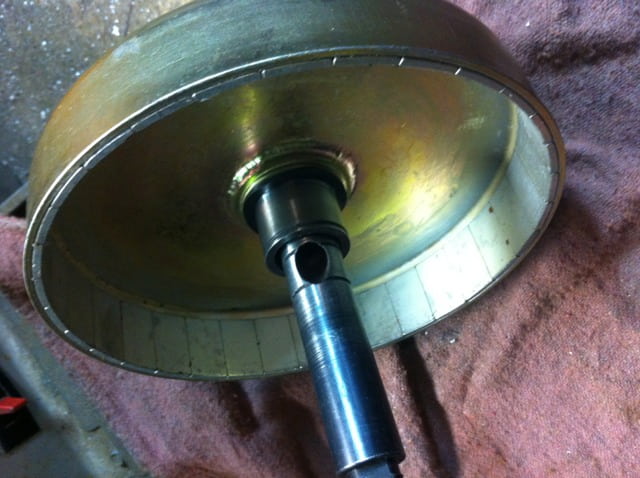
Pic of the skeletonized STEEL magnet-bowl of the Fusin geared hub, to reduce weight:
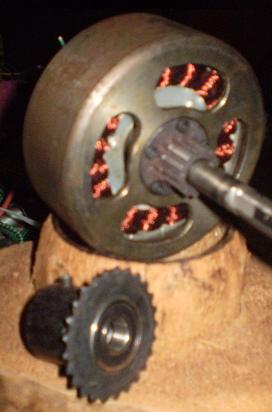
Skeletonized aluminum stator-core on the BMC to save weight:

As far as weight, I like that the MAC has more copper mass than the GNG-V1
If you like that idea, but want extra quiet, consider getting a slow 12T, converting it to shaft-drive, and removing the planets. Make an aluminum adapter to pin the shaft to the sun-gear on the magnet-ring/bowl, and add a belt-reduction to the 17mm shaft. You can also use a hole-saw to remove 40% of the mass of the magnet-bowl, so it looks like the Bafang magnet-bowl.
edit: the un-geared 12T MAC has a Kv of approximately 30...30-RPMs per volt,...6T is 60-Kv, and so the 8T would be around 45-Kv. Concerning cumbersome reductions, the GNG-V1 has a Kv of 67, and at 72V, it is pretty much a "no pedal" scooter with the pedal cadence being way too fast to add any pedaling. There is nothing wrong with that, but the MAC/BPM both have lower Kvs, more copper mass, and 40% greater magnetic flux leverage (due to being outrunners).
On adding a belted primary (removing the stock gears): Of course this would require cutting a significant opening in the planet-gear side of the motor casing for the belt to get out. I would recommend keeping 4 of the six side-plate screws (one in the center of the belt-path with two cut-out openings for the belt), and three screws on the front half of the sideplate (this is to add rigidity to the shaft bearing location). There may only be room for a 15mm wide belt to exit a stock-width motor case (IDK), but you could add spacers under the sideplate and use longer attachment bolts so the sideplate is moved farther out. That would make more room for a wider belt.
Its all experimental at this point, but the potential benefits are too appealing for me to stay away. Even if its a complete bust, this is a lot of fun for me. I spun the motor recently as a shaft-drive using 24V and an RC sensorless ESC. The motor seemed to spin fine in forward and also reverse. Does anyone know if the MAC neutrally timed?
Pic of the solid STEEL magnet-bowl on the MAC:
Pic of the skeletonized STEEL magnet-bowl of the Fusin geared hub, to reduce weight:
Skeletonized aluminum stator-core on the BMC to save weight:

bandaro
10 kW
Yeah, I also like the fact the hub motors have far more torque, the ability to remove that pesky speed reduction that plagues the rc outrunner builds is very enticing, if the reduction can be removed then so can 90% of the rc motor problems. So a converted hub could easily and very neatly be mounted onto the bike, use generic speed controllers kit, and in general be far more user friendly.
As I said, having the weight in the motor lets the motor take far more abuse, sink too much power into a sub 1kg rc motor and you get toast, sink the same power into a heavy hub and it can survive, as there is so much more mass to take up the heat. I do like your suggestion of the shaft drive, but more in the sense that it could be an effective way to reduce the width of the system, the chain noise isn't so much of an issue for me, I'm more after a light and powerful system.
I just hear horror stories about the weight of hub motors, being 5-8kg for a decent motor, and for me that is too heavy, especially after the mounting weight is included. Rough calculations put my current thoughts of a design at around 3kg fully mounted, without batts. So for half the weight I can deal with a little noise for now. Is this weight true for the macs? I haven't been able to find a weight for a converted, mounted system...
As I said, having the weight in the motor lets the motor take far more abuse, sink too much power into a sub 1kg rc motor and you get toast, sink the same power into a heavy hub and it can survive, as there is so much more mass to take up the heat. I do like your suggestion of the shaft drive, but more in the sense that it could be an effective way to reduce the width of the system, the chain noise isn't so much of an issue for me, I'm more after a light and powerful system.
I just hear horror stories about the weight of hub motors, being 5-8kg for a decent motor, and for me that is too heavy, especially after the mounting weight is included. Rough calculations put my current thoughts of a design at around 3kg fully mounted, without batts. So for half the weight I can deal with a little noise for now. Is this weight true for the macs? I haven't been able to find a weight for a converted, mounted system...
crossbreak
1 MW
hi bandaro,
consider, that power to weight ratio of the motor increases with RPM. So a converted hub will never be as lightweight as a highspeed RC motor. But if you build an oversized and heavy reduction gearbox for an RC motor, power to weight ratio will become equal. I like these hubs more, since they spin slower and are more quiet. Still, I do not see the point in throwing out the great planetary drive, a chain is more heavy and less compact, it's not enclosed and so on. Only drawbacks IMO.
Anyway, if you want a good power to weight ratio, stick to a low pole count motor like the bafang BPM or an RC outrunner. The MAC is high pole count, can not spin fast and though has low power to weight ratio, still the worst choice for conversion IMO.
consider, that power to weight ratio of the motor increases with RPM. So a converted hub will never be as lightweight as a highspeed RC motor. But if you build an oversized and heavy reduction gearbox for an RC motor, power to weight ratio will become equal. I like these hubs more, since they spin slower and are more quiet. Still, I do not see the point in throwing out the great planetary drive, a chain is more heavy and less compact, it's not enclosed and so on. Only drawbacks IMO.
Anyway, if you want a good power to weight ratio, stick to a low pole count motor like the bafang BPM or an RC outrunner. The MAC is high pole count, can not spin fast and though has low power to weight ratio, still the worst choice for conversion IMO.
I want to state for the record that I agree with crossbreak on the low-pole count of the Bafang. Although I am impressed by the build quality of the MAC, the reason that I am posting a complete pic-tutorial on the MAC is simply that...GreenMachine gave me a MAC to work with.
I plan to do the same with the Bafang-BPM, but as GM has told me...everything always takes longer than we plan! GreenMachines exposure to endless-sphere has been like the tip of an iceberg...he is an exceptional individual, and a very interesting person.
I have only taken on two projects in the past to show that they can be done (links in my sig below). A friction-drive made with only a hacksaw, drill, and a vice. And also a full-suspension longtail bike with no welder. There are other wonderful projects here on ES, but they are already done and posted, so I don't need to do one to show what the performance would be.
My fascination with this shaft conversion is that it results in an outrunner that is a 145-30 with five available Kv's between 30 and 60. Those Kv's are low enough that any builder can make a single-reduction drive. The magnetic flux (air-gap) between the stator-teeth and magnets is 40% farther away from the shaft than the GNG-V1, and the MAC/Bafang has more copper mass.
Normally, one of these geared hubs has a poor heat-shedding path compared to the inrunner GNG-V1. GreenMachine has beaten on these like a rented mule, and the heat-bridge that crossbreak engineered works surprisingly well at drawing heat from the stator-core out to the aluminum sideplate. The thick GM sideplate works pretty great as a passive heat sponge to draw-out and dissipate stator-heat, but the fat aluminum sideplate also offers an opportunity to add outside air-cooling or oil-cooling the sideplate alone, without introducing dust or oil to the motor interior.
I plan to do the same with the Bafang-BPM, but as GM has told me...everything always takes longer than we plan! GreenMachines exposure to endless-sphere has been like the tip of an iceberg...he is an exceptional individual, and a very interesting person.
I have only taken on two projects in the past to show that they can be done (links in my sig below). A friction-drive made with only a hacksaw, drill, and a vice. And also a full-suspension longtail bike with no welder. There are other wonderful projects here on ES, but they are already done and posted, so I don't need to do one to show what the performance would be.
My fascination with this shaft conversion is that it results in an outrunner that is a 145-30 with five available Kv's between 30 and 60. Those Kv's are low enough that any builder can make a single-reduction drive. The magnetic flux (air-gap) between the stator-teeth and magnets is 40% farther away from the shaft than the GNG-V1, and the MAC/Bafang has more copper mass.
Normally, one of these geared hubs has a poor heat-shedding path compared to the inrunner GNG-V1. GreenMachine has beaten on these like a rented mule, and the heat-bridge that crossbreak engineered works surprisingly well at drawing heat from the stator-core out to the aluminum sideplate. The thick GM sideplate works pretty great as a passive heat sponge to draw-out and dissipate stator-heat, but the fat aluminum sideplate also offers an opportunity to add outside air-cooling or oil-cooling the sideplate alone, without introducing dust or oil to the motor interior.
Similar threads
- Replies
- 18
- Views
- 742
- Replies
- 11
- Views
- 881
- Replies
- 12
- Views
- 10,348

